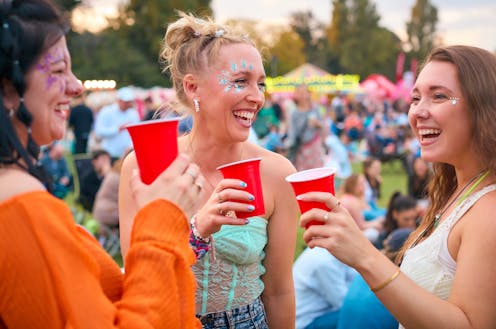
It’s finally summer festival season – and the heat is on!
Hopefully, the warm weather’s what you wanted – we all know it’s miserable getting stuck in a cold, wet field, watching your wellies slowly sink into the mud.
Mud permitting, festival life can be phenomenal – but it’s not without its dangers. That classic festival combo of too much booze and sun can lead to more than just dehydration and an absolutely banging hangover the next day.
So, if you’re off on a festival adventure this summer, here’s a bit of advice from your friendly GP anatomist.
Extremes of temperature
Consider a trip to Glastonbury as you would an expedition to the Gobi desert: festival goers can be exposed to a whole range of temperatures, even in summer. While a full sun can send temperatures skyrocketing during the day, by nightfall temperatures can plummet.
Heat exhaustion has a whole range of associated symptoms, including nausea, vomiting, headaches, weakness and more – in conjunction with a high temperature. If you start to experience any of these symptoms, stop and think. It’s possible to turn things around once you’ve recognised you’re overheating.
Seek shelter, drink plenty of fluids and cool down by whatever means available: strip off, apply cold packs and sit in front of a fan, if possible.
Read more: The best way to cool down quickly and safely in a heatwave
Heatstroke can develop from heat exhaustion. This is not a trivial condition. It is a medical emergency that can culminate in seizures, collapse, and even death. Failing to respond to 30 minutes of cooling, or severe symptoms like loss of consciousness, confusion or a racing heart, warrants emergency intervention.
Developing hypothermia at a festival might sound unlikely, but is entirely possible – and it’s as much of a medical emergency as heatstroke. Hypothermia is defined as a body temperature lower than 35°C, which affects the function of all the organ systems of your body. Symptoms such as shivering, confusion, and cold, pale or mottled skin indicate hypothermia. Warm up by layering clothing and blankets and call for emergency help.
Even if it’s cloudy, sunburn is a risk at outdoor festivals. Ignore social media influencers advising against sunscreen use: protect your skin and layer on the factor 50. Make sure you reapply it after washing (yes, you should still have a wash – even at a festival) and at least every two hours.
No one’s 20s and 30s look the same. You might be saving for a mortgage or just struggling to pay rent. You could be swiping dating apps, or trying to understand childcare. No matter your current challenges, our Quarter Life series has articles to share in the group chat, or just to remind you that you’re not alone.
Read more from Quarter Life:
Alcohol and fluid balance
Alcohol can contribute to a great festival experience when enjoyed sensibly but it can also cause more problems than it’s worth.
Take dehydration for starters. You may notice that you pee more after drinking alcohol, and since you’re taking in fluids this makes sense, but it isn’t a simple case of volume in equals volume out. Alcohol has a diuretic effect on the body, so it increases urine output from the kidneys. It does this via its effect on a hormone called vasopressin, which makes your kidneys retain water rather than excreting it. Alcohol inhibits vasopressin release, making you lose more water and become vulnerable to dehydration.
Dehydration can trigger hangovers from hell – but also other more severe conditions like seizures, shock and heatstroke. Even if you’re not drinking alcohol, it’s still essential to stay hydrated throughout the day, aiming for around 1.5 to 2 litres of non-alcoholic fluids during waking hours. But extra will be needed in hot weather, or if you’re exercising (yes, that includes dancing).
Read more: Why most hangover cures don't work but a few might help – new study
Then there’s alcohol poisoning if you drink it to excess - again far from trivial. Diabetic festival goers need to take even more care since alcohol can interfere with the conversion of glycogen stored in the liver into glucose leading to critically low blood sugar levels.
As in any social space, be aware of drink spiking. Don’t leave drinks unattended and be cautious about accepting drinks from others.
Sexual Health
The transmission of sexually transmitted infections (STIs) at festivals has been the subject of lots of research, which has informed health campaigns. Some studies have examined the effect of dating app use on casual sex in festival goers. Some research suggests that festival STI transmission could be higher than estimated.
Remember that hormonal contraception including pills, implants and mirena coils do not protect against STIs – instead, use a condom. Using a dental dam during oral sex can also reduce the risk of contracting a STI.
Conceiving during a festival is not just a plotline from Bridget Jones.
No form of contraception offers a 100% guarantee against pregnancy and might fail to prevent it. Therefore, if you miss a pill, or a condom splits, it’s important to seek medical advice on what to do next as soon as you can.
So, to make sure you have an amazing time during festival season, pack plenty of sunscreen and condoms, stay hydrated and limit the booze. Report any concerns to first aiders or medical personnel on call. After all, you don’t want heatstroke, dehydration or an STI to become the headline act of your festival experience.
Dan Baumgardt does not work for, consult, own shares in or receive funding from any company or organisation that would benefit from this article, and has disclosed no relevant affiliations beyond their academic appointment.
This article was originally published on The Conversation. Read the original article.







